MARIANI’SVirtual Gourmet
October 16, 2011
NEWSLETTER
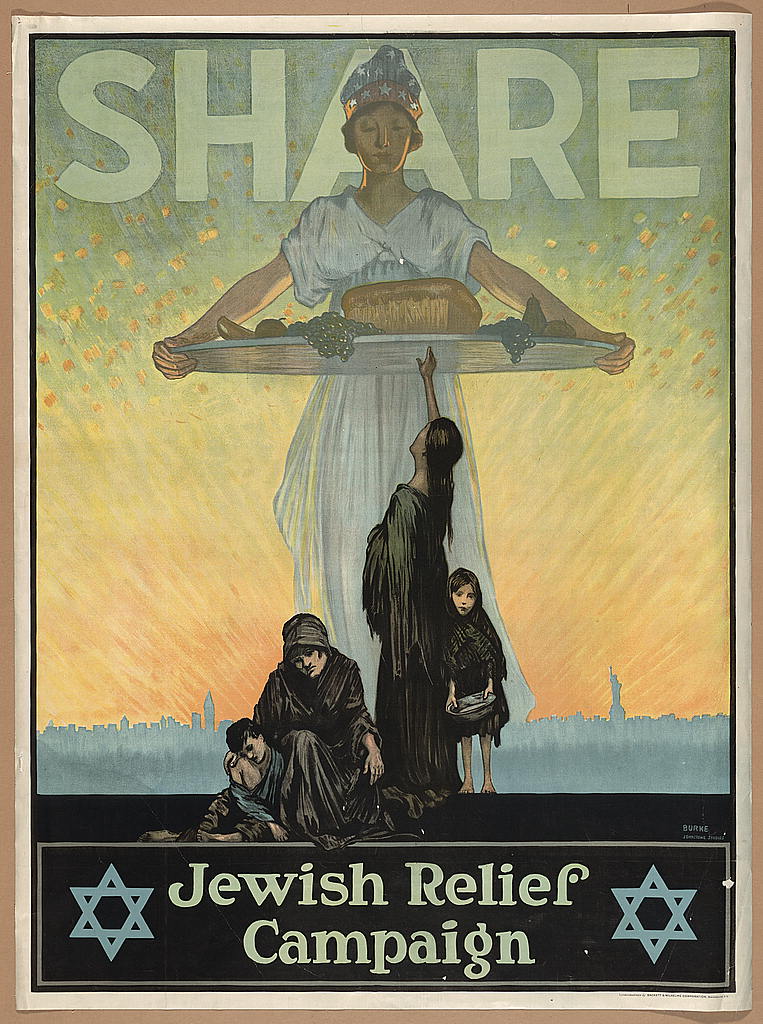
THIS WEEK
ESQUIRE'S BEST NEW RESTAURANTS IN AMERICA 2011
by John Mariani
DAY TRIPPER: ANTWERP, BELGIUM
by John Mariani
NEW YORK CORNER: LA GRENOUILLE
by John Mariani
MAN ABOUT TOWN
ESQUIRE MAGAZINE HOLDS 27TH ANNUAL "BEST NEW
RESTAURANTS IN AMERICA" PARTY AT BOULUD SUD
by Christopher Mariani
THE TEARS OF CHRIST AND THE TAIL OF THE WOLF NOW
DISTINGUISH CAMPANIA'S WINE
by John Mariani
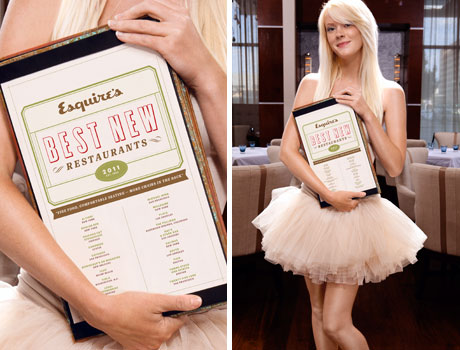
ESQUIRE'S
BEST NEW RESTAURANTS IN AMERICA 2011.
The November issue of Esquire
Magazine contains my annual (27th year)
article on the Best New Restaurants in America
for 2011, along with a dozen "Not to Be
Missed," Hostess of the Year Hanna Mary
Marshall (left),
Best Cookbooks, and much more. And see the
report below on the Esquire party!
| Ai Fiori, NYC Boulud Sud, NYC Chicago Cut Steakhouse, Chicago Congress, Austin Cotogna, San Francisco Dominique’s, New Orleans 1500˚, Miami Beach Fiola, Washington DC Playa, Los Angeles--John Sedlar-Chef of the Year Towne Stove & Spirits--Boston |
Legal Harborside,
Boston Lincoln Ristorante, NYC Michael Mina, San Francisco--Restaurant of the year Millesime, NYC The Pullman, Glenwood Springs, CO Ray’s & Stark Bar, Los Angeles Salinas, NYC Tico, Boston 25 Lusk—San Francisco Sotto, Los Angeles |
CHEFS
TO KEEP YOUR EYE ON
Scott Anderson, Elements, Princeton, NJ
Tyler Brown, The Capitol Grille, The Hermitage,
Nashville, TN
Todd Richards, Café at
the Ritz-Carlton,
Buckhead, GA
A DOZEN MORE NEW
RESTAURANTS NOT
TO BE MISSED
Bondir, Cambridge,
MA
El Real, Houston
Girl & the Goat, Chicago
Husk,
Charleston, SC
Lucia, Dallas
Lyon Bouchon, NYC
Citizen Public
House,
Scottsdale, AZ
Manzo, NYC
Michel-by-Michel
Richard, Tyson’s Corner, VA
Paris Club,
Chicago
Public Kitchen
& Bar, Los Angeles
Virtue Food & Grain,
Alexandria, VA.
Where
to Eat in South Florida Right Now
Why
You Can't Get That Dinner Reservation
Big cities demand a traveler's commitment to stay
put for several days, or, as has been said of great
cities like New York, Rome, London and Paris, if you
spend a week there you'll know the city well; if you
spend a lifetime, you'll realize how much you don't
know. Smaller cities, however, can be visited with
pleasure for a day or two, to take in the principal
sights and determine if you want to return for a
longer stay. In fact, I find such visits
extremely enjoyable and, more often than not, make
me hunger for more. This article is the first in a
continuing, occasional series I call "Day Trippers,"
intended to give the reader a quick, broad overview
of a city where I was delighted for just a day or
two. --John Mariani
by
John Mariani
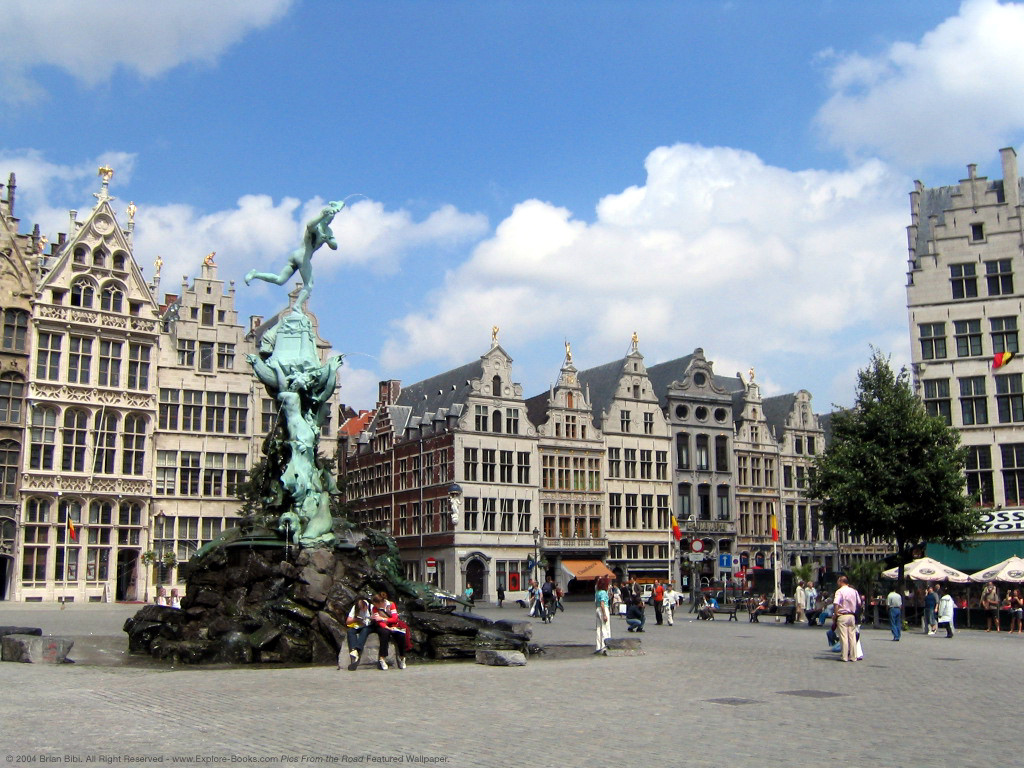
Old
Market Square
Now doesn't that sound like the most boring place on earth? Wikipedia goes on: "Renowned for being the world's
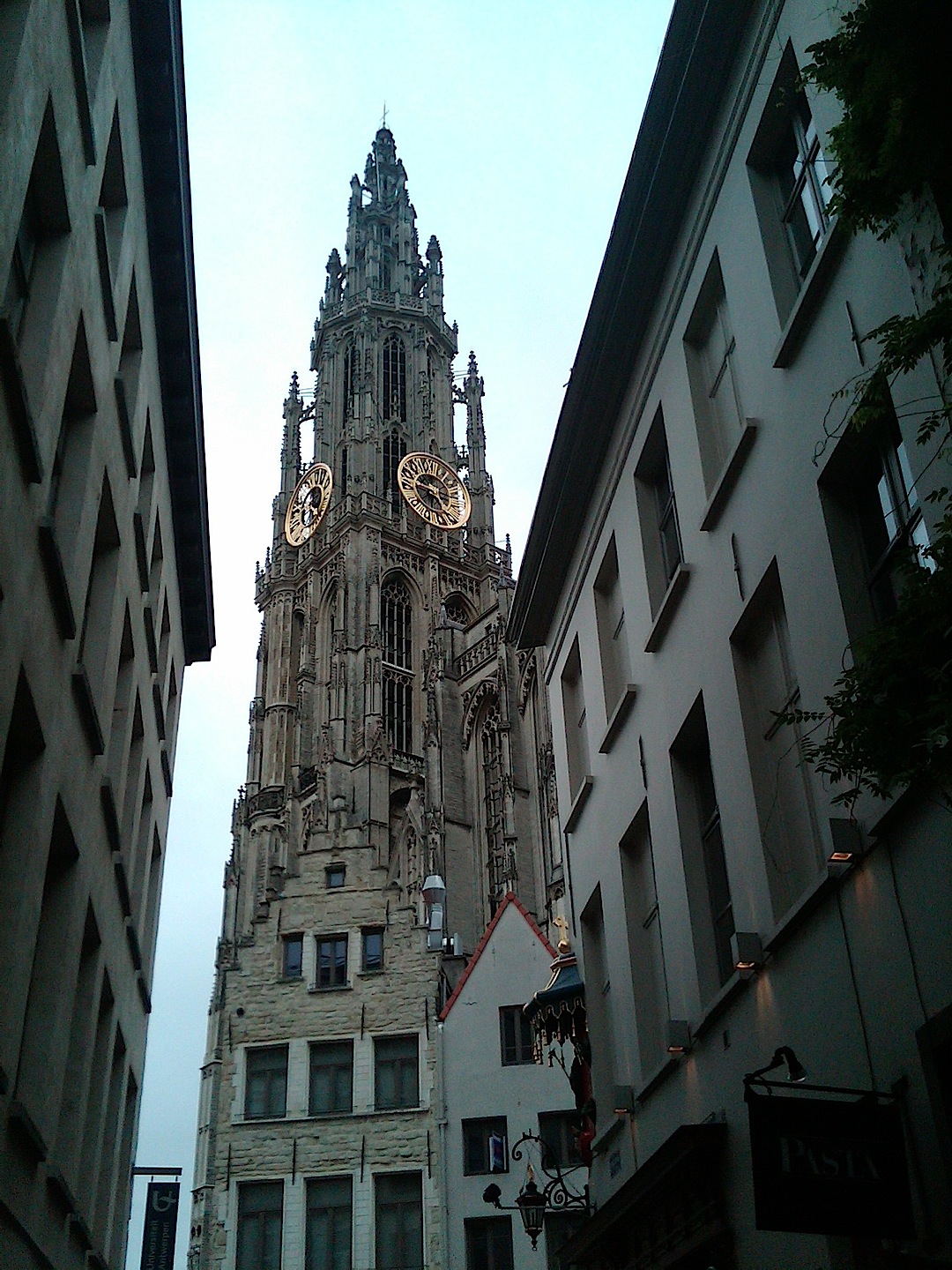 leading diamond city." Now there's a nifty
reason to visit!
leading diamond city." Now there's a nifty
reason to visit! In fact, Antwerp is a city of great beauty, medieval and baroque grandeur, and a modernity that would dwarf such notions in cities like Florence, Lisbon, and everywhere in France outside Paris. It is a city of young people on sensible bicycles, who love their hometown and glide through its every byway, crisscrossing the grand plazas, along the river, through warrens of boutique-lined streets, and not wearing bike helmets. It is a city where the natives love and take their time with the good life, which includes a deep-seated beer culture and an embrace of both traditional and contemporary cuisines. They love their Belgian chocolates--arguably the best in the world--and their history reflects a solid grounding in business and commerce, along with some empire building.
The strictly touristic pleasures are many and very varied, beginning with the impressive Cathedral of Our Lady (right), finished in 1351. Still in the process of being impeccably restored, it is an edifice of soft light, with the usual internal extravagance driven by the Catholic Church's embrace of those wealthy enough to demand it. In fact, I learned from our guide--a beautiful woman named Carolien Krijnen, whose knowledge and personality seemed to sum up the proud spirit of the city--that because rich people were buried in graves under the marble floors of the cathedral, their relatives' eventual burial in the same site required digging up the slabs, which was quite a malodorous experience for the grave diggers, leading the rest of the population, buried in outdoor graveyards, to call the dead people in the church the "stinking rich." The cathedral is decked out with some very impressive Rubens paintings, too.
For those who cannot get enough of the artist's flamboyantly fleshy style, there is also Rubenshuis, Rubens's house. I also recommend a stop at the Plantin Moretus Museum, the beautifully secluded home of a 16th century bookbinder and printer Christoffel Plantin, now dedicated to a the history of printing.
Antwerp's historic center and City Hall is Old Market Square (above), built around the famous Gothic and early Renaissance guild houses of merchants, artisans, and city leaders who helped make Belgium exceedingly rich in their day. The buildings' stateliness may reflect the sober-sided business soul of the city, but it is softened by their decorous touches, and in the center is the tall, curious statue of a legend about a terrible giant who repeatedly attached the city, finally vanquished by an improbable Italian hero who tore off the giant's huge hands and to this day holds them up for everyone to see.
Ms. Krijnen calls her city of 500,000 inhabitants and 165 nationalities "a village with an attitude," and you'll connect to that in the main shopping area called the Meir, not far from the train station, where the international designers are located, but the cooler, more stylish and indigenous boutiques are to be found in the artists' district in the south end of the city, especially along Kammenstraat, where several of
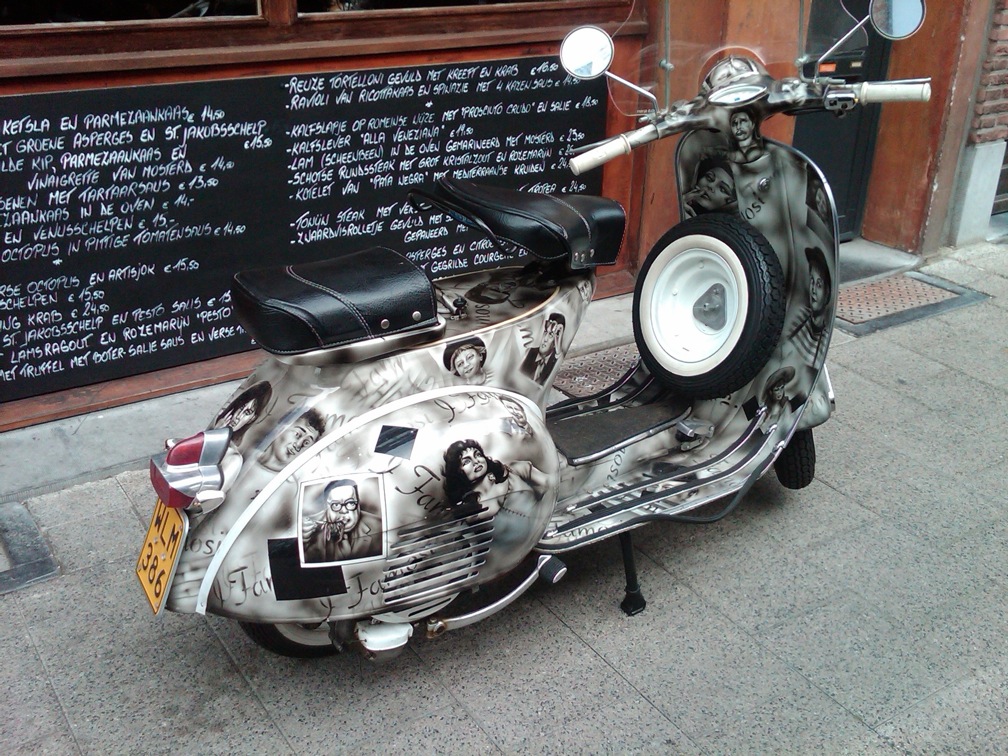 those boutiques even
hold wine tastings. These are hip spots, like Hospital
Clothing and Clinic Clothing (it
has a dentist's chair inside the door), promoting
Belgian designers. Noë by
Your (left),
which sells "Sex in the City" TV series videos, is known
for its signature women's pumps--in 65 colors! There is
even a notable
Fashion Museum, with shows constantly changing.
And don't forget, the impish Smurfs were created in
Belgium.
those boutiques even
hold wine tastings. These are hip spots, like Hospital
Clothing and Clinic Clothing (it
has a dentist's chair inside the door), promoting
Belgian designers. Noë by
Your (left),
which sells "Sex in the City" TV series videos, is known
for its signature women's pumps--in 65 colors! There is
even a notable
Fashion Museum, with shows constantly changing.
And don't forget, the impish Smurfs were created in
Belgium. If you're in town for the weekend, head for the Theaterplein Square market, where you can buy most anything at all.
Belgians revel in their food and drink with good reason, not least their exquisite chocolates--Günther Watte is a superb shop at 30 Steenhouwersvest--and their crisp, yeasty waffles (created in Ghent) that you find in stalls throughout the city, along with Belgian fried potatoes, doused with any number of toppings, from vinegar to mayonnaise and curry.
At lunch you might want to nosh on a smos sandwich, whose name means a "mess," the expected outcome of eating multilayers of bread and garnishes. Belgians love their beer and gin (I will have an upcoming story on Belgian beers in a November issue of the Virtual Gourmet), so cafés dot every street. Some of the best known include the old Den Engel at Grote Market; Kulminator, with 700+ beers listed; and De Vagant, which carries 300 kinds of jenever, the gin-based spirit of the Benelux countries.
The city teems with eateries, snack shops, beer halls, cafés, and restaurants of every ethnic stripe (there's even a small Chinatown), many along De Keyserlei near the station. The oldest restaurant in the city (1750) is the seafood-centric Rooden Hoed, whose six mussel dishes are ranked among the best in this mussel-mad city. In the South End, Famosi Italian restaurant justifies its boast, and it's a pretty hip spot, with a Vespa out front painted with Italian movie stars painted all over it (right).
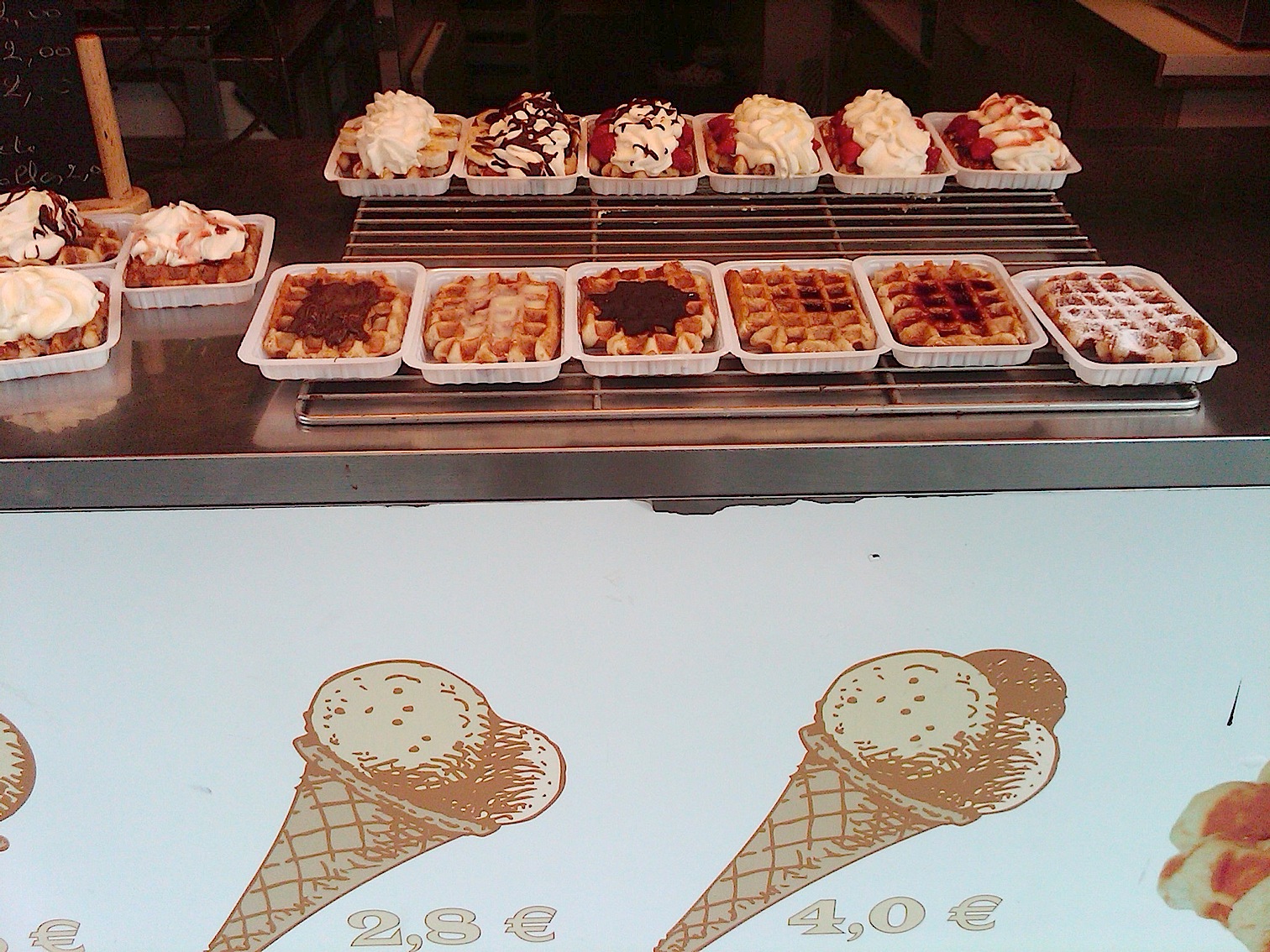 We ate that evening at De
Groote Witte Arend, another very old spot, dating
to 1488 and once a convent, but since 1976 a beer hall
and restaurant, now owned by Tim and Ronald
Ferket, who serve up very hearty Belgian fare along with
280 beers. We enjoyed a beer-dark beef stew with potato
croquettes, sautéed plaice with mashed potatoes,
a loin of pork, and some delicious eel baked in
cream. For dessert there was a crêpe filled
with vanilla cream sabayon whipped with Belgian beer.
We ate that evening at De
Groote Witte Arend, another very old spot, dating
to 1488 and once a convent, but since 1976 a beer hall
and restaurant, now owned by Tim and Ronald
Ferket, who serve up very hearty Belgian fare along with
280 beers. We enjoyed a beer-dark beef stew with potato
croquettes, sautéed plaice with mashed potatoes,
a loin of pork, and some delicious eel baked in
cream. For dessert there was a crêpe filled
with vanilla cream sabayon whipped with Belgian beer. 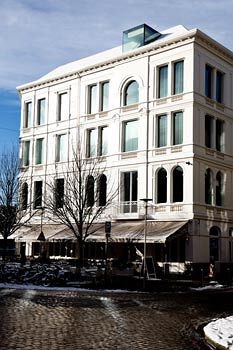
And that put a nightcap on our Day Trip to Antwerp. We returned to Hotel O (right), which is very new and very conveniently located across from the tram stops. Its owner, however, seems to have decided to be the most modern hotel in Europe, which means he's installed all card keys that must be waved in front of doors and elevators but don't always work, light switches that are very tricky to use, and, at least in our case, a room completely painted black, which might have amused Mick Jagger, but was tough to navigate because the light switches were also in black and the bathroom, too. There was also no closet we could find or hooks on which to hang our clothes. We did, however, look into our friends' all white room, complete with closet space and a big white bathtub. That was a very splendid room and if you book at the hotel, ask for one of these brighter rooms. The staff--all of whom, like everyone in Belgium--speaks perfect English to help you along, and there is a casual brasserie at ground floor offering a good breakfast, included in the room price.
Were I to return to Antwerp another day--and I must happily would--I'd wile away my time at a slow pace. It is a great walking city, a city to nosh in, take in a gallery show, sit in a café on a plaza and nibble fried potatoes. And, since city bicycles may be rented for the day, I'd hop on one and ride down every street and get to know this beautiful city just the way the people of Antwerp know it.
NEW
YORK CORNER
by John Mariani
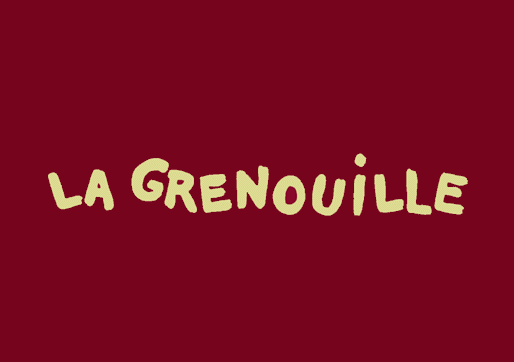
3 East 52nd Street (near Fifth Avenue)
212-752-1495
www.la-grenouille.com
An
argument might be made that there is
really no need to update an article on Le
Grenouille.
Since opening its doors on
December 19, 1962, during a snowstorm, little
seems
to have changed about all that made it so
wonderful in the first place. 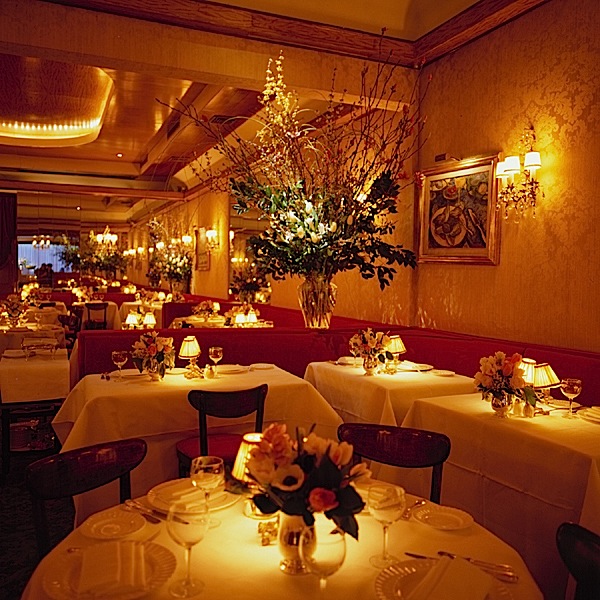 True,
Charles Masson, the redoubtable French owner
of this resolutely French restaurant, passed
away in 1975, and his wife Gisele has retired,
but their son Charles, a fine painter whose work
hangs here, is still the one to greet
you, the one who makes sure the room is
spectacularly beautiful and the kitchen
willing to carry on the traditions of French
classic cuisine. The famously grand flower
display is still primped and changed
constantly, the red banquettes are clean as
candy apples, and the mirrors gleam and
visually double the space.
True,
Charles Masson, the redoubtable French owner
of this resolutely French restaurant, passed
away in 1975, and his wife Gisele has retired,
but their son Charles, a fine painter whose work
hangs here, is still the one to greet
you, the one who makes sure the room is
spectacularly beautiful and the kitchen
willing to carry on the traditions of French
classic cuisine. The famously grand flower
display is still primped and changed
constantly, the red banquettes are clean as
candy apples, and the mirrors gleam and
visually double the space.
Still, while La Grenouille
(which its society habitués call "the
Frog Pond") seems always the same, under
Charles the Younger all has evolved, almost
imperceptibly, but the menu is more
interesting that it ever had been, and there
are two new chefs, Noah Metnick and Colin
Whiddon, behind the swinging
kitchen doors; then again, they'd been working
here for some time before their
elevation. Thus, good enough reason for
a return visit and an assessment of how
everything's going.
Masson the Elder had been
on the staff of the original Le Pavillon
restaurant at the 1939 World's Fair, and
afterwards at the restaurant of the same name
when manager Henri Soulé re-located it
in Manhattan, where Le Pavillon set a
mold--some would say a straitjacket--for haute
French cuisine and haughtiness that affected
all the others to follow, like La Chaumiére, La
Chansonette, Laurent, Le Marmiton, Le
Madrigal, and La Grenouille, all looking quite
alike, all with the same rarely changing menu.
Regulars were favored, the rich and famous
fawned over, while many people merely
interested to dine at such places were too
often snubbed.
Over the years the
clientele aged, some died off, and began
to change, as did a more egalitarian approach
to hospitality, with Charles the Younger
insisting long-entrenched,
complacent captains and waiters adapt to new
times, not least to attract a younger
clientele who had no patience for Gallic
hauteur.
The once brassy-green colors have been toned down
by golden lighting 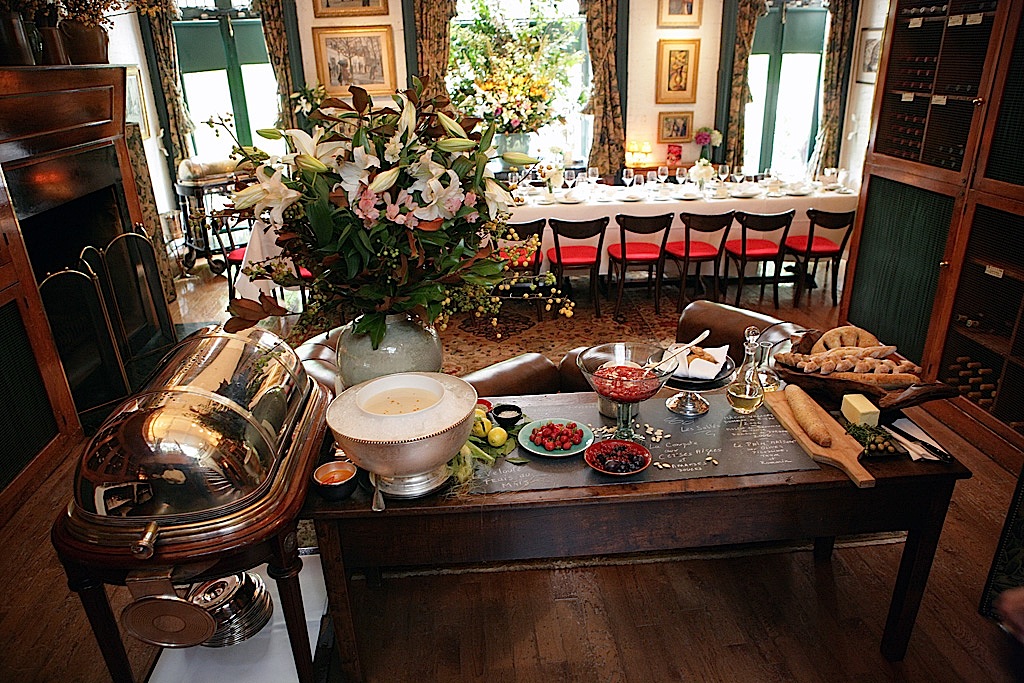 and flattering tones in the dining room
and they fall with soft benediction on everyone; the
greeting is cordial, and Mr. Masson is clearly
delighted you have chosen to dine at his family's
restaurant. Upstairs (left) a 70-seat private dining room
is one of the loveliest in the city, with fireplace
and walls of wine, and at lunch offers a three-course
$36 "ardoise"
(written on a slate, as shown below, left) meal.
and flattering tones in the dining room
and they fall with soft benediction on everyone; the
greeting is cordial, and Mr. Masson is clearly
delighted you have chosen to dine at his family's
restaurant. Upstairs (left) a 70-seat private dining room
is one of the loveliest in the city, with fireplace
and walls of wine, and at lunch offers a three-course
$36 "ardoise"
(written on a slate, as shown below, left) meal.
The
New York food critics have overall been very generous
in their idolatry of La Grenouille, as much for the
décor as for the food, even though there has
never been a celebrated chef in the kitchen; indeed,
the restaurant's chefs were barely ever known at all.
The Times
would rave about boiled shrimp in tomato dressing and
"masterpieces" like poached chicken with champagne
cream sauce. Ironically, the Michelin Guide has never
seen fit to award La Grenouille even a single star,
giving just three forks-and-spoons ("very
comfortable"), calling it the "Judi Dench of French
dining."
My own affection for the restaurant
falls somewhere between the Michelin's cool regard and
the multi-star effusions of the NYC media who
lavish praise on dishes that can easily be found just
as impeccably prepared at dozens of other NYC
restaurants, French or not, many happily going by the
name bistro, brasserie, even gastropub. For
instance, there is foie gras terrine with brioche; a
poached egg with leeks; lobster and tarragon ravioli;
Dover sole with mustard sauce; filet mignon; and lamb
chops with thyme--nothing not on the menu at
restaurants of lesser status, including Millesime,
Benoit, Balthazar, Spotted Pig, and many others.
Compared to other deluxe French restaurants
like Le Bernardin, Daniel, and Le Cirque, the
menu at La Grenouille has not tried particularly hard
to keep up with the evolution--I did not say
trends--of French or global cuisine.
That said, it is still one of the
most glorious experiences in NYC to dine at La
Grenouille and I always look for excuses to do so. One
presented itself the other night and I dined with four
people, some of whom had never dined there before,
duly impressed by the beauty of the surroundings. The
place, as always, was packed, with an array of patrons
that included white-haired regulars, a few foreigners,
and an engaging number of young people obviously
celebrating. Most guests were dressed appropriate to
the ambiance. Jackets are still required downstairs
for gentlemen but not neckties; Mr. Masson told
me that he once lost a table of six people because two
of the men turned on their heels when asked to don a
house tie or ascot. I cannot speak of all the women's
outfits, though I did notice a disquieting pair of red
jeans on a woman who should have known better.
We were presented with a lovely
little amuse
of carrot and ginger soupo laced with chive oil, while
looking over the $98 menu (with a few too many
supplements),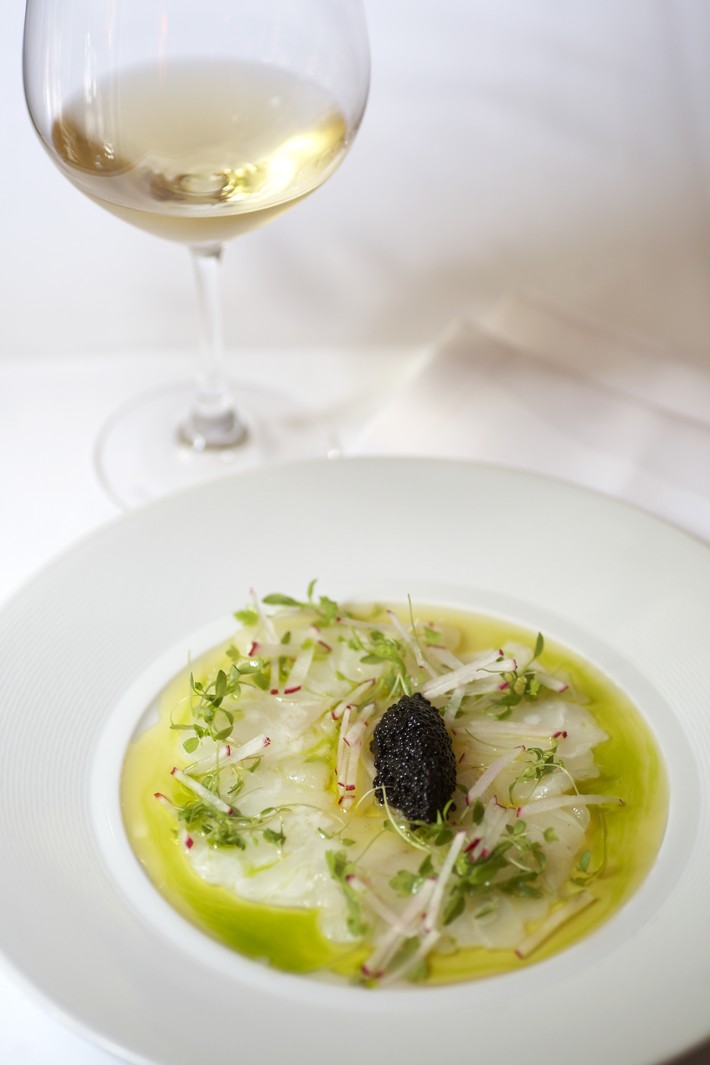 while the
captain (now in suit and tie, no longer tuxedo) told
us of the selection of oysters for the evening along
with a single plat du jour, a veal chop with
pearl onions, chanterelles, thyme bay leaves and
lardons. As an appetizer, I ordered a silky terrine de foie gras
edged in pale yellow fat, with two big slabs of
toasted housemade brioche. (By the way, the five of us
had to share just three pats of butter set on our
table.) My friend had the fresh, seared foie gras
dashed with Calvados apple brandy and served with
slices of sweet autumn apples. A nicely al dente risotto
came with wild mushrooms.
while the
captain (now in suit and tie, no longer tuxedo) told
us of the selection of oysters for the evening along
with a single plat du jour, a veal chop with
pearl onions, chanterelles, thyme bay leaves and
lardons. As an appetizer, I ordered a silky terrine de foie gras
edged in pale yellow fat, with two big slabs of
toasted housemade brioche. (By the way, the five of us
had to share just three pats of butter set on our
table.) My friend had the fresh, seared foie gras
dashed with Calvados apple brandy and served with
slices of sweet autumn apples. A nicely al dente risotto
came with wild mushrooms.
In between courses the chef sent
out an unexpected tartare of fluke (right) with
thinly sliced cucumbers, radishes, a zing of lime
juice, the crunch of pistachios, and a small
dollop of caviar--simple and perfect at that point in
the meal, especially since it preceded my impeccably
cooked Dover sole on the bone à la meunière, which
the staff will happily de-bone, if you like, served
with haricots verts.
And therein lies a modern urban tale: the busboys wear
these odd white caddy's caps, the reason being that
the NYC Health Department denotes anyone who prepares
food a "food handler," who must wear hats and plastic
gloves, which applies to those busboys because they
might be called on to bone a fish or slice
salmon. Good reason to march on City Hall, I'd
say.
Oxtail was braised in
Burgundy wine to a deep red-brown hue, caramelized
with onions and vegetables, the kind of bistro-style
dish you might not expect at La Grenouille but
rendered with gusto. The special of the night veal
chop was of fine flavor. Other offerings
on the menu include loup de mer with
Swiss chard, barley risotto, onion soubise and
lemon; veal kidney with a classic mustard sauce,
flamed in cognac; and magret of duck with figs and
turnips (years ago this last would have been roast
duckling, carved tableside by a captain in a tux).
La Grenouille has always been
known for its perfect soufflés---and the
captain will announce at the beginning of your
evening that they are made to order and carry a
supplement to the prix fixe. Frankly, I find
this a bit outdated on two counts: any trained cook
knows how to prep soufflés so that they don't
take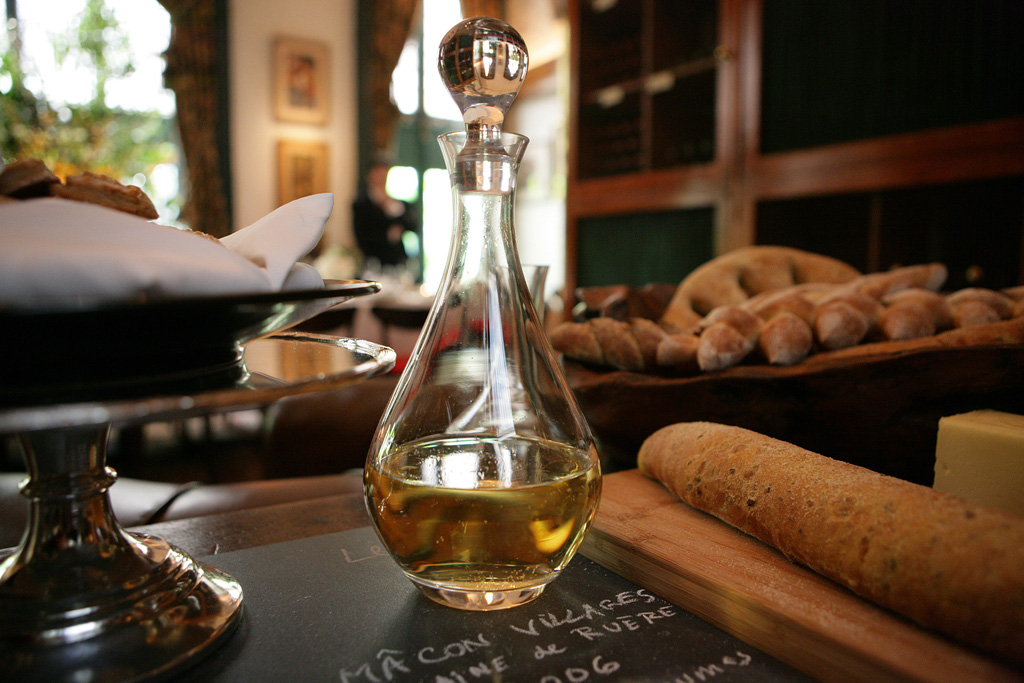 a lot of time or effort
to make, and, therefore, do not justify a supplement
for a dish of flavored eggs and sugar.
Nevertheless, La Grenouille's are
nonpareil--practice makes perfect and I reckon since opening in 1962 they must
have made several hundred thousand of them. We
chose chocolate and caramel, with crème
anglaise. Individual tarte Tatins were stubby,
little tightly-packed, caramelized apple cakes,
succulent to the core. The pastry chef is Matt
Lambie.
a lot of time or effort
to make, and, therefore, do not justify a supplement
for a dish of flavored eggs and sugar.
Nevertheless, La Grenouille's are
nonpareil--practice makes perfect and I reckon since opening in 1962 they must
have made several hundred thousand of them. We
chose chocolate and caramel, with crème
anglaise. Individual tarte Tatins were stubby,
little tightly-packed, caramelized apple cakes,
succulent to the core. The pastry chef is Matt
Lambie.
La Grenouille's wine list,
overseen by sommelier Guillaume Chamot-Rook, is of
good size, 220 labels, richest in French bottlings,
of course, but not cheap, especially the
whites. We put ourselves in Mr. Masson's hands
to choose for us--some of us having seafood, others
meat or foie gras--and his choices were excellent,
including a Sauternes for the foie gras, a Burgundy
for the meats, and, graciously, Champagne for the
desserts.
It was
drizzling that night in NYC outside La Grenouille,
but if ever I needed a haven from the storm, this is
a restaurant where it is the easiest thing in the
world not to give a thought to anything else going
on in the
world. Its beauty is undeniable, though I'm
not sure whether it is due to extravagant
restraint or restrained extravagance. The room
positively glows, the service has great refinement,
and, with Mr. Masson always there to greet you, the
sense that all is well within the brocade, mirrored
world of La Grenouille begins when you push through
the doors till the moment you regretfully
leave. But you'll do so with a distinct
feeling of great satisfaction, which these days in
NYC is not often what it once was. La
Grenouille embraces and wins you over, like
the words in Edith Piaf's signature song "La Vie en
Rose,"
Je vois la vie en rose.
La Grenouille is open for lunch and dinner Tues.-Sat.; Lunch fixed price $45 or $60; Bar menu $16-$28; 3-course ardoise men $36; Dinner $98.

MAN ABOUT TOWN
by Christopher Mariani
Party at Boulud Sud

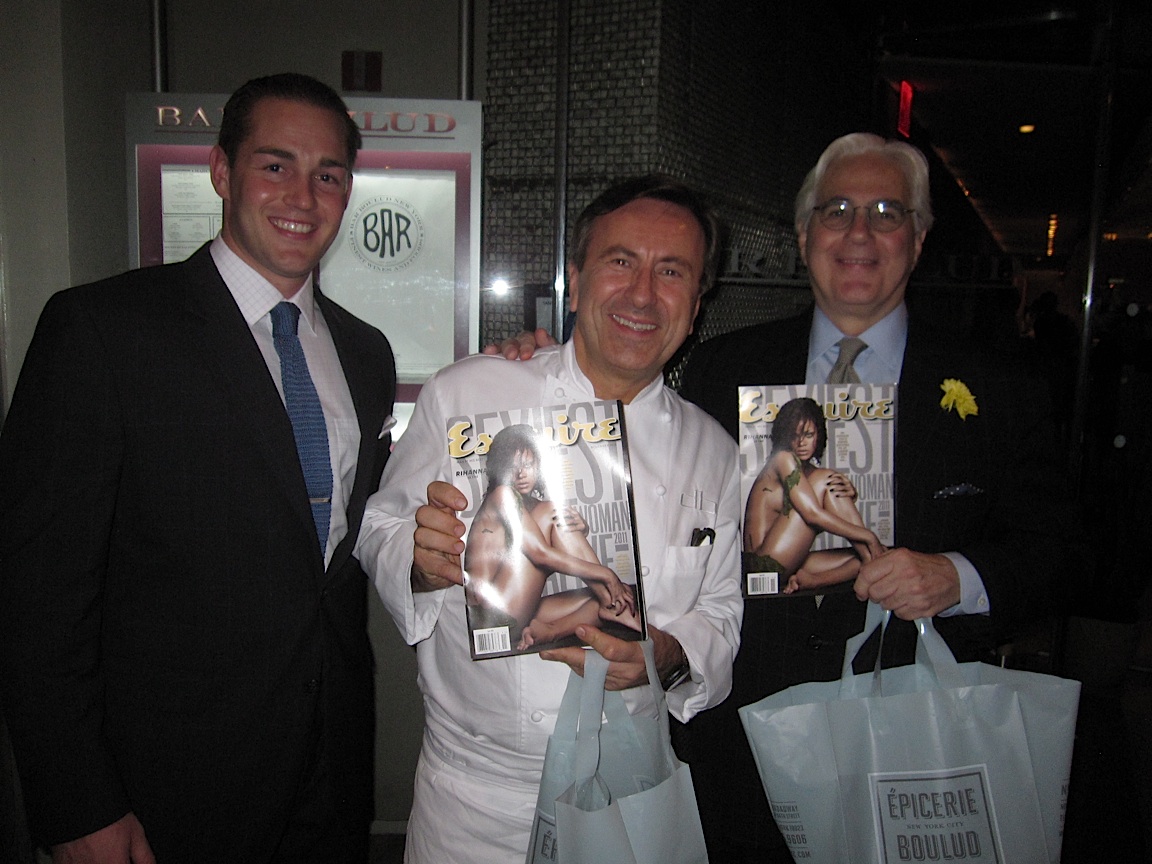 celebration among a group of highly
talented chefs from around the country, including
Boulud (with yours
truly and John Mariani, left), Michael
White of Ai Fiori,
Jonathan Benno of Lincoln
Ristorante, Lydia Shire of Towne Stove &
Spirits, and many more. The annual gala rounds up
some of the country’s finest chefs, all within the pages
of the November issue of Esquire Magazine.
Michael Mina’s namesake restaurant Michael
Mina, in San Francisco took home the restaurant of
the year award while John Sedlar of Playa in Los
Angeles, won the award for chef of the year.
celebration among a group of highly
talented chefs from around the country, including
Boulud (with yours
truly and John Mariani, left), Michael
White of Ai Fiori,
Jonathan Benno of Lincoln
Ristorante, Lydia Shire of Towne Stove &
Spirits, and many more. The annual gala rounds up
some of the country’s finest chefs, all within the pages
of the November issue of Esquire Magazine.
Michael Mina’s namesake restaurant Michael
Mina, in San Francisco took home the restaurant of
the year award while John Sedlar of Playa in Los
Angeles, won the award for chef of the year.The night kicked off with a grand cocktail reception while Boulud’s handsome wait staff served up some terrific canapés—sea urchin and crab tartine over crunchy crackers, vitello tonnato served on a spoon, lamb kibbeh and an herb falafel. These delicate hors d’oeuvres were all washed down with wonderful Italian sparkling rosé from Castello Banfi, which also paired their wines with Boulud’s four-course meal throughout the evening, including their marvelous Cum Laude blend of sangiovese, Cabernet, merlot and syrah. Also in attendance was French actress and vigneron Carole Bouquet, who graciously brought her Sangue d'Oro wine, a sweet Passito di Pantelleria she had us try with the savory appetizers.
Once seated, Esquire’s editor-in-chief, David Granger, began the evening with a short speech thanking and congratulating the participants before handing over the microphone to Mariani, who would spend part of the night awarding each chef from the 2011 best new restaurants list.
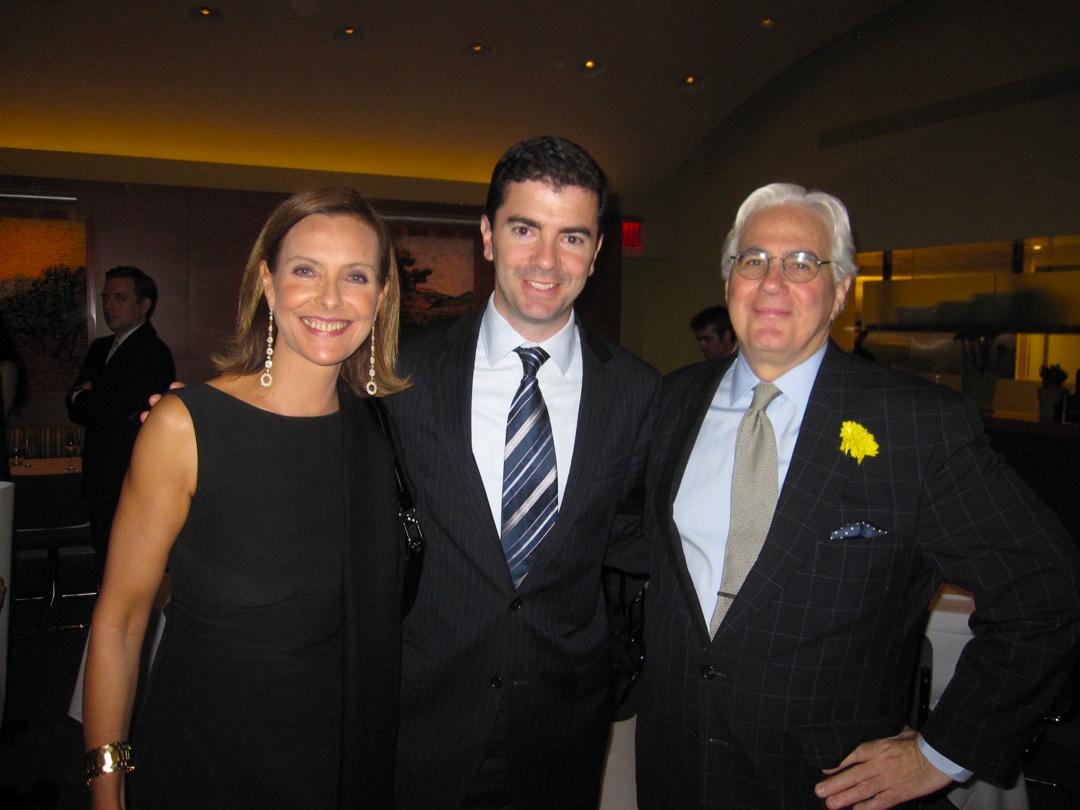 As usual, Mariani made clear that he picks
these restaurants primarily on chef-centered
restaurants, the food and the distinctive flavors, along
with a comical but true list of what Esquire frowns
upon, like “Restaurants where any cast member from
`Jersey Shore’ would be allowed to dine” and
“Restaurants where there is a beets-and-goat’s-cheese
salad on the menu 365 days a year.”
As usual, Mariani made clear that he picks
these restaurants primarily on chef-centered
restaurants, the food and the distinctive flavors, along
with a comical but true list of what Esquire frowns
upon, like “Restaurants where any cast member from
`Jersey Shore’ would be allowed to dine” and
“Restaurants where there is a beets-and-goat’s-cheese
salad on the menu 365 days a year.”Each chef spoke briefly, thanking Esquire and Mariani for the award, expressing their joy to be part of such an elite group of talent. The majority of chefs, unlike so many “portrayed” on television, do not like socializing with their guests or showing their faces in the dining room. They’d rather speak through their food and stay within the comfort of their kitchens. So, to have all these chefs come up and speak in front of such an audience of peers and media was a charming reflection of the kind of unpretentiousness that is the true spirit of their professionalism. There were old chefs, new chefs, established chefs, up-and-coming chefs, tall chefs, short chefs,
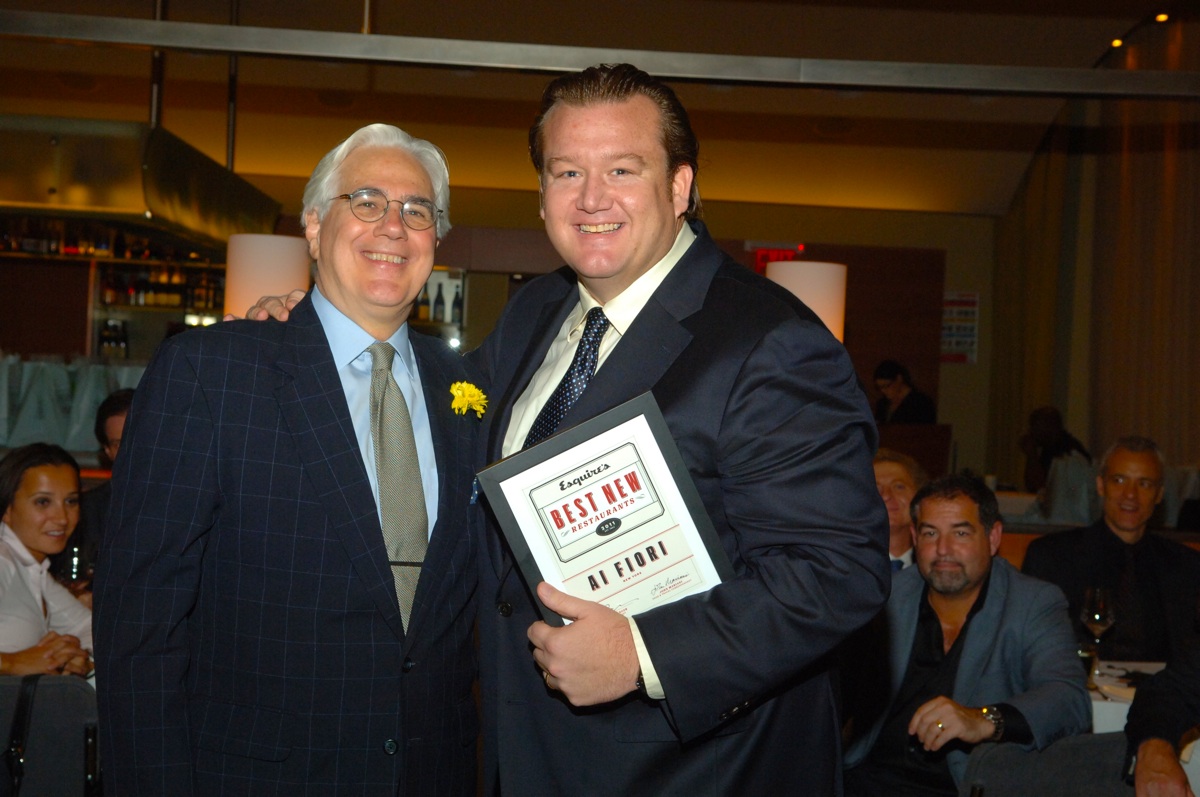 chefs with accents and chefs
without Southern drawls. The group chosen for this year’s best new
restaurants proves that Esquire picks
one of the most eclectic collections of any magazine or
rating guide. The beauty of these awards is that you can
be a Mom and Pop restaurant and receive the identical
award as does someone like Daniel Boulud.
chefs with accents and chefs
without Southern drawls. The group chosen for this year’s best new
restaurants proves that Esquire picks
one of the most eclectic collections of any magazine or
rating guide. The beauty of these awards is that you can
be a Mom and Pop restaurant and receive the identical
award as does someone like Daniel Boulud.At the end, Mariani praised French cooking as still the underpinning all modern cuisine, then, noting how Boulud Sud resembles Rick's Café Americaine in the movie "Casablanca," gathered the French chefs and attendees to lead a rendition of the French national anthem, "La Marsellaise." The evening finished across the street with a few bottles of prosecco at Lincoln Ristorante.
John Mariani and Michael White of Ai Fiori
America is a diverse country with cities, towns, and suburbs that showcase all different types of cuisines and styles, and Mariani does a damn good job of giving them all proper recognition. Above is the official list of “Esquire’s Best New Restaurants for 2011.”
To contact Christopher Mariani send an email
to christopher@johnmariani.com
The Tears of
Christ and Tail of the Fox
Now Distinguish Campania’s Wines
by
John Mariani
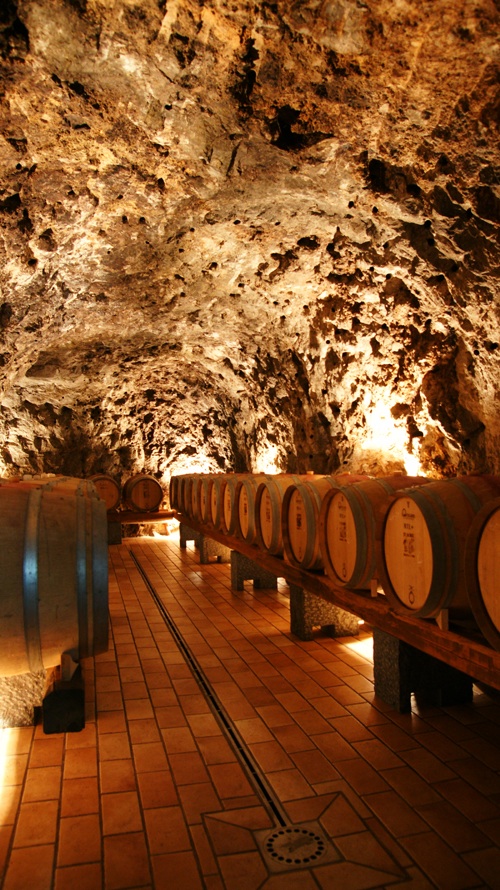 Nostalgia
and pride of place always play a part in the love of
regional wines, whether it’s the Loire Valley or the
banks of the Rhine. It’s hard not to be in thrall to a
local wine when you’re drinking it on the island of
Capri overlooking the Tyrrhenian Sea. But until
recently I would be hard put to defend the overall
quality of the wines my ancestors drank in Campania,
the region of Capri, Naples, and the Amalfi Coast.
Nostalgia
and pride of place always play a part in the love of
regional wines, whether it’s the Loire Valley or the
banks of the Rhine. It’s hard not to be in thrall to a
local wine when you’re drinking it on the island of
Capri overlooking the Tyrrhenian Sea. But until
recently I would be hard put to defend the overall
quality of the wines my ancestors drank in Campania,
the region of Capri, Naples, and the Amalfi Coast.
Indeed,
prior to my great grandparents’ emigration to America in
1888, they hadn’t a clue what kind of wines they were
drinking back in the Old Country, where no one had
ever tried to classify one grape from another. In
those days, as in most of Italy, most grapes were self
propagating, a condition called “promiscuous
cultivation,” and the vines had to compete with other
plants for water and nutrients, thereby producing
wines of little character. Oxidation was considered
characteristic; wine was sold almost exclusively from
huge old oak barrels.
Even after Italy’s Ministry of Agriculture
established its denomination of wine origins in 1963,
it was a frustrating job to delineate the distinctions
among dozens of Campanian grapes like greco, fiano,
falanghina, biancolella and coda di volpe (tail of the
fox).
The first Campanian
winery of any real note was Mastroberardino in
Avellina, which in the 1970s pioneered the red wines
of taurasi and ancient near-defunct white varietals
like fiano. Now,
as throughout Italy, modern viticulture and technology
have allowed a young breed of Campanian winemakers to
reveal the distinctiveness of their terroirs, from
vineyards near Mount Vesuvius to the island of Capri
and to the rocky hill towns of the Picentini
Mountains.
“What’s important about Campanian wines now,”
says restaurateur and wine writer Joseph Bastianich,
“is that they are showing the potential of true
indigenous Italian varietals that are just beginning
to express themselves.” He says they sell 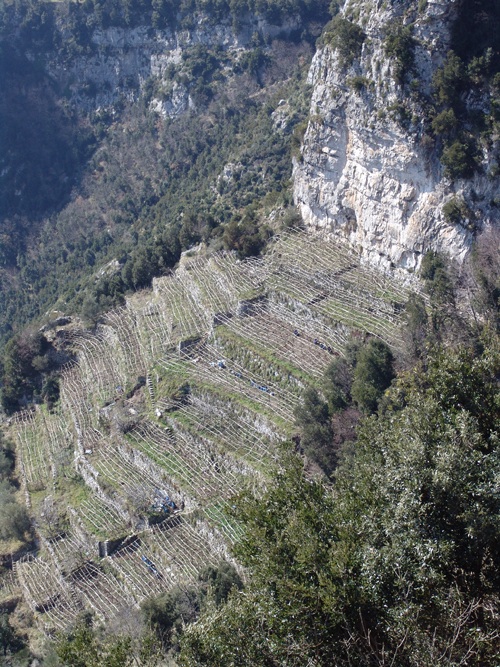 more of them
at his mid-range restaurants like Esca and Lupa than
the high-end Babbo and Del Posto, all co-owned with
Mario Batali.
more of them
at his mid-range restaurants like Esca and Lupa than
the high-end Babbo and Del Posto, all co-owned with
Mario Batali.
Currently Campania has three D.O.C.G.
appellations (guaranteed quality)—fiano di avellino,
greco di tufo, and taurasi; 18 D.O.C. and nine I.G.T.
wines. Fiano
is said to taste of the piney woods of its region of
Irpinia; greco di tufo, imported from ancient Greece,
was originally cultivated around Mount Vesuvius, where
it later took the name Lacyrma Christi (“tears of
Christ”). Taurasi is a big, robust, long-aging red
made from aglianico, whose name derives from ellenico
(Greek).
I was able to purchase a good
selection of Campanian wines from a new wine shop, San
Pietro Wine & Spirits in Tuckahoe, NY, whose
owners, the Bruno brothers (they run New York’s San
Pietro and Caravaggio restaurants), are from Campania
and therefore proudly promote the wines of the region.
San Salvatore
Paestum Fiano 2009 ($19.99)—Made near the sea
around Salerno, this fiano has a characteristic flinty
crispness, and a little brininess that makes it ideal
with Neapolitan seafood like branzino and orata.
Marisa Cuomo Costa
d’Amalfi Fiorduva 2008 ($62.99—The price is
astonishing for a white Campanian wine, but Marisa
Cuomo is one of the stars of the region, and this
blend of falanghina and biancolella, planted 500
meters above the sea, is enormous and very rich. To
appreciate fully its character, I’d serve it with the
simplest of seafood on the grill. If the price puts
you off, her Furore Blanco 2009—“white fury”—at $22.99
is still a big mouthful, almost a little fizzy upon
being opened, and with 13.5 percent alcohol, excellent
for a dish of spaghetti with clam sauce.
Luigi Maffini Kratos 2010
($21.99)—Another of Campania’s bright young lights,
Luigi Maffini modernized his father’s winery of four
cultivated hectares, which now produces about 40,000
bottles of reds and whites. His Kratos vineyard
produces a very pretty white wine in the sense of it
light and well balanced between fruit and acid, citrus
and apple flavors, making it a wonderful wine with
linguine with garlic and oil or shellfish in a spicy
tomato sauce.
Villa Matilde Falanghina
2010 ($14.99)—Usually this quite simple wine
lacks body and texture, but I found Villa
Matilde’s—with a big 14 percent alcohol--to have a the
perfume of the Mediterranean in its nose, sun-rich
fruit and a clean, acidic finish. The wine is so good
on its own, I’d serve it as an aperitif with slices of
Prosciutto or with a Caprese salad of mozzarella and
fresh tomatoes and basil.
Campi Flegrei Piedrosso
2008 ($17.99)—A dominant red varietal in
Campania, piedrosso has weight and heft, and Campi
Flegrei, near Naples, respects that. Its aromatic
aroma lasts and lasts, and fruit and tannin flow
easily on the palate. This is an $18 wine I’d gladly
pay double for.
John Mariani's wine column appears in Bloomberg Muse News, from which this story was adapted. Bloomberg News covers Culture from art, books, and theater to wine, travel, and food on a daily basis.
YOU CAN’T MAKE THIS STUFF UP

Hooters sued the partner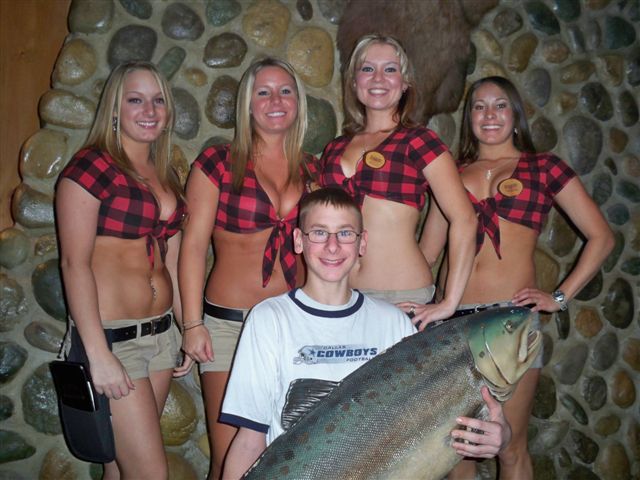 of a rival in Georgia
federal court, accusing the La Cima company
developing a Twin Peaks chain, with 15 restaurants on
five states, and a former Hooters executive of
stealing trade secrets. Twin Peaks
restaurants motto would be : “Eats, Drinks, Scenic
Views.” Please note that Hooters waitresses wear trademark white
tank tops and orange short shorts (left), Twin Peaks
s wear a flannel bikini-like tops and hiker shorts (right). In the
lawsuit, Hooters contends the Hooters Girls are the
“cornerstone of the [Hooters] concept,” and that “Twin
Peaks directly competes with [Hooters] in the market
of casual dining restaurants with an all female
waitstaff.”
of a rival in Georgia
federal court, accusing the La Cima company
developing a Twin Peaks chain, with 15 restaurants on
five states, and a former Hooters executive of
stealing trade secrets. Twin Peaks
restaurants motto would be : “Eats, Drinks, Scenic
Views.” Please note that Hooters waitresses wear trademark white
tank tops and orange short shorts (left), Twin Peaks
s wear a flannel bikini-like tops and hiker shorts (right). In the
lawsuit, Hooters contends the Hooters Girls are the
“cornerstone of the [Hooters] concept,” and that “Twin
Peaks directly competes with [Hooters] in the market
of casual dining restaurants with an all female
waitstaff.”
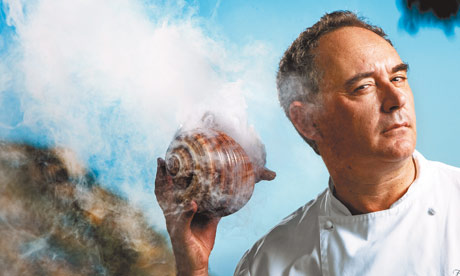
"If it
hadn't been for the first omelette, I wouldn't have
been able
to do the other thousand omelettes. Now I need a girl
or a
woman in a miniskirt." --Ferran Adria.
Any of John Mariani's
books below may be ordered from amazon.com.
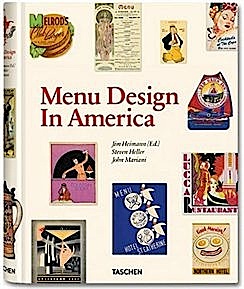 |
My latest book, written with Jim Heimann and Steven Heller, Menu Design in America, 1850-1985 (Taschen Books), has just appeared, with nearly 1,000 beautiful, historic, hilarious, sometimes shocking menus dating back to before the Civil War and going through the Gilded Age, the Jazz Age, the Depression, the nightclub era of the 1930s and 1940s, the Space Age era, and the age when menus were a form of advertising in innovative explosions of color and modern design. The book is a chronicle of changing tastes and mores and says as much about America as about its food and drink.
“Luxuriating vicariously in the pleasures of this book. . . you can’t help but become hungry. . .for the food of course, but also for something more: the bygone days of our country’s splendidly rich and complex past. Epicureans of both good food and artful design will do well to make it their cofee table’s main course.”—Chip Kidd, Wall Street Journal.
“[The menus] reflect the amazing craftsmanship that many restaurants applied to their bills of fare, and suggest that today’s restaurateurs could learn a lot from their predecessors.”—Rebecca Marx, The Village Voice.
“Restaurateurs, take note: A resurgence in thoughtful, artistic menus is past due.”—Bon Appetit Magazine |
"Eating Italian will never be the same after reading John Mariani's entertaining and savory gastronomical history of the cuisine of Italy and how it won over appetites worldwide. . . . This book is such a tasteful narrative that it will literally make you hungry for Italian food and arouse your appetite for gastronomical history."--Don Oldenburg, USA Today. "Italian
restaurants--some good, some glitzy--far
outnumber their French rivals. Many of
these establishments are zestfully described
in How Italian Food Conquered the World, an
entertaining and fact-filled chronicle by
food-and-wine correspondent John F.
Mariani."--Aram Bakshian Jr., Wall Street
Journal.
"Equal parts
history, sociology, gastronomy, and just
plain fun, How Italian Food Conquered the
World tells the captivating and delicious
story of the (let's face it) everybody's
favorite cuisine with clarity, verve and
more than one surprise."--Colman Andrews,
editorial director of The Daily
Meal.com. "A fantastic and fascinating
read, covering everything from the influence
of Venice's spice trade to the impact of
Italian immigrants in America and the
evolution of alta cucina. This book will
serve as a terrific resource to anyone
interested in the real story of Italian
food."--Mary Ann Esposito, host of PBS-TV's
Ciao
Italia. "John Mariani has written the
definitive history of how Italians won their
way into our hearts, minds, and
stomachs. It's a story of pleasure over
pomp and taste over technique."--Danny Meyer,
owner of NYC restaurants Union Square Cafe,
Gotham Bar & Grill, The Modern, and
Maialino.
|
 |
 |
 |
 |
 |
 |
 |
 |
 Everett Potter's Travel Report:
Everett Potter's Travel Report: 
 Eating Las Vegas
is the new on-line site for Virtual Gourmet
contributor John A. Curtas., who since 1995
has been commenting on the Las Vegas food
scene and reviewing restaurants for Nevada
Public Radio. He is also the
restaurant critic for KLAS TV, Channel 8 in
Las Vegas, and his past reviews can be
accessed at KNPR.org.
Click on the logo below to go directly to
his site.
Eating Las Vegas
is the new on-line site for Virtual Gourmet
contributor John A. Curtas., who since 1995
has been commenting on the Las Vegas food
scene and reviewing restaurants for Nevada
Public Radio. He is also the
restaurant critic for KLAS TV, Channel 8 in
Las Vegas, and his past reviews can be
accessed at KNPR.org.
Click on the logo below to go directly to
his site.

Tennis Resorts Online: A Critical Guide to the World's Best Tennis Resorts and Tennis Camps, published by ROGER COX, who has spent more than two decades writing about tennis travel, including a 17-year stretch for Tennis magazine. He has also written for Arthur Frommer's Budget Travel, New York Magazine, Travel & Leisure, Esquire, Money, USTA Magazine, Men's Journal, and The Robb Report. He has authored two books-The World's Best Tennis Vacations (Stephen Greene Press/Viking Penguin, 1990) and The Best Places to Stay in the Rockies (Houghton Mifflin, 1992 & 1994), and the Melbourne (Australia) chapter to the Wall Street Journal Business Guide to Cities of the Pacific Rim (Fodor's Travel Guides, 1991).

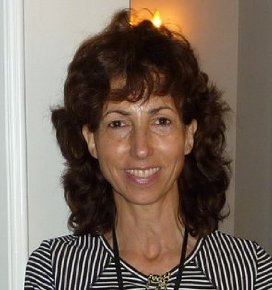
The Family Travel Forum - A
community for those who "Have Kids, Still Travel" and
want to make family vacations more fun, less work and
better value. FTF's travel and parenting features,
including reviews of tropical and ski resorts, reunion
destinations, attractions, holiday weekends, family
festivals, cruises, and all kinds of vacation ideas
should be the first port of call for family vacation
planners. http://www.familytravelforum.com/index.html
ALL YOU NEED BEFORE YOU GO


MARIANI'S VIRTUAL GOURMET
NEWSLETTER is published weekly. Editor/Publisher: John
Mariani.
Contributing Writers: Christopher Mariani, Robert Mariani,
John A. Curtas, Edward Brivio, Mort Hochstein,
Suzanne Wright, and Brian Freedman. Contributing
Photographers: Galina Stepanoff-Dargery,
Bobby Pirillo. Technical Advisor: Gerry McLoughlin.
© copyright John Mariani 2011
